
Dino was a marque best known for mid-engined, rear-drive sports cars produced by Ferrari from 1957 to 1976. The marque came into existence in late 1956 with a front-engined Formula Two racer powered by a brand new Dino V6 engine. The name Dino was used for some models with engines smaller than 12 cylinders, it was an attempt by the company to offer a relatively low-cost sports car. The Ferrari name remained reserved for its premium V12 and flat-12 models until 1976, when "Dino" was retired in favour of full Ferrari branding.
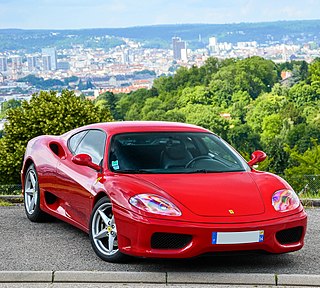
The Ferrari 360 is a two-seater, mid-engine, rear wheel drive sports car manufactured by Italian automotive manufacturer Ferrari from 1999 until 2004. It succeeded the Ferrari F355 and was replaced by the Ferrari F430 in 2004.

The Ferrari Berlinetta Boxer (BB) is series of sports cars produced by Ferrari in Italy between 1973 and 1984. The BB was designed by Leonardo Fioravanti at Pininfarina. The first BB model, the 365 GT4 BB, replaced the front engined Daytona and was the first in a series of road-going Ferraris equipped with a mid-mounted flat-twelve engine. It was also the first mid-engined road-car to bear the Ferrari name and the Cavallino Rampante logo. The 365 GT4 BB was succeeded in 1976 by the BB 512, equipped with a larger displacement engine, then by the fuel-injected BB 512i in 1981. The series was discontinued in 1984 when the BB 512i was replaced by the Testarossa, which used a revised version of the flat-twelve engine.
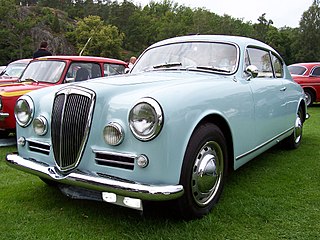
A grand tourer (GT) is a type of car that is designed for high speed and long-distance driving due to a combination of performance and luxury attributes. The most common format is a front-engine, rear-wheel-drive two-door coupé with either a two-seat or a 2+2 arrangement. Grand tourers are most often the coupé derivative of luxury saloons or sedans. Many iconic car models, such as the Ferrari 250 GT, Jaguar E-Type, and Aston Martin DB5, are considered classic examples of gran turismo cars.
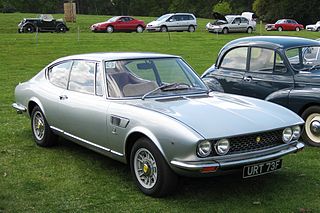
The Fiat Dino was a front-engine, rear-wheel-drive sports car produced by Fiat from 1966 to 1973. The Dino name refers to the Ferrari Dino V6 engine, produced by Fiat and installed in the cars to achieve the production numbers sufficient for Ferrari to homologate the engine for Formula 2 racing.

The Lancia Stratos HF, known as Lancia Stratos, is a rear mid-engined sports car designed for rallying, made by Italian car manufacturer Lancia. It was a highly successful rally car, winning the World Rally Championship in 1974, 1975 and 1976; and race car winning 1974 Targa Florio, five times the Tour de France Automobile and three editions of Giro d'Italia automobilistico.
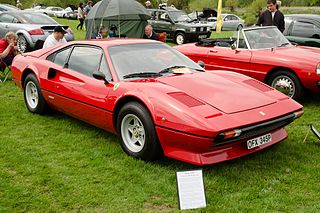
The Ferrari 308 GTB berlinetta and targa topped 308 GTS are V8 mid-engined, two-seater sports cars manufactured by the Italian company Ferrari from 1975 until 1985. The 308 replaced the Dino 246 GT and GTS in 1975 and was updated as the 328 GTB/GTS in 1985. The similar 208 GTB and GTS were equipped with a smaller, initially naturally aspirated and later turbocharged, two-litre engine, and were sold mainly in Italy.

The Dino 308 GT4 and 208 GT4 were mid-engined V8 2+2 cars built by Ferrari. The Dino 308 GT4 was introduced in 1973 and supplemented by the 208 GT4 in 1975. The cars were sold with Dino badging until May 1976, when they received Ferrari badging. The GT4 was replaced by the Mondial 8 in 1980 after a production run of 2,826 308s and 840 208s.
The Ferrari Dino engine is a line of mechanically similar V6 and V8 engines produced by Ferrari for about 40 years from the late 1950s into the early 2000s.

Vittorio Jano was an Italian automobile designer of Hungarian descent from the 1920s through 1960s.
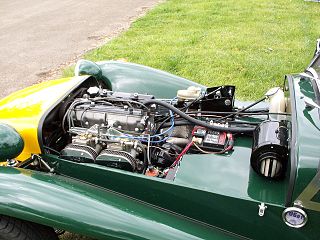
The Fiat Twin Cam is an advanced double overhead camshaft inline-four automobile engine produced from 1966 through 2000 as a Fiat/Lancia engine. Designed by ex Ferrari engineer Aurelio Lampredi, the engine was produced in a large number of displacements, ranging from 1.3 to 2.0 L and was used in Fiat, Lancia, Alfa Romeo, SEAT, FSO and Morgan cars. The Fiat Twin Cam engine has been widely used in motorsport and has been the most successful engine in the history of the World Rally Championship. Fiat and Lancia won a total of ten World Rally Championships for Manufacturers using engines based on the Lampredi Twin Cam engine. It was replaced by the Fiat "family B" Pratola Serra engine series.

The Lancia Montecarlo is a Pininfarina-designed mid-engined sports car produced by Lancia in Italy from 1975 to 1981.

The Lancia Rally was a mid-engine sports car and rally car built by Lancia in the early 1980s to compete in the FIA Group B World Rally Championship. Driven by Markku Alén, Attilio Bettega, and Walter Röhrl, the car won Lancia the manufacturers' world championship in the 1983 season. It was the last rear-wheel drive car to win the WRC.

Bburago is a manufacturing company of toys and die-cast scale model cars formerly based in Italy. The company was based in Burago di Molgora, where all products were made from 1974 to 2005. At the height of its popularity, Bburago's main competitors were Politoys and Maisto, the latter of which was to become dominant in the 1:18 market segment around 2000.

Kelmark Engineering was an American automotive specialty shop established in 1969 and based in Okemos, Michigan. It focused on high-performance custom V8 drivetrain swaps, the modification and production of rear and mid-engined cars, and custom-built turn-key automobiles. Until 1986, Kelmark Engineering manufactured kits and complete, finished, turn-key vehicles which were either Volkswagen-based or built on tubular race car-type frames. The outfit gained its name from Russ Keller and Randy Markham, the two co-creators who started the operation. Up until at least 1989, the Kelmark GT was still available as a kit albeit the manufacturer was Kelmark Motors in Holt, Michigan. The cars are all "rare" models, but the Volkswagen-powered Kelmark GT was the most popular.
The Turin Motor Show was an auto show held annually in Turin, Italy. The first official show took place between 21 and 24 April 1900, at the Castle of Valentino, becoming a permanent fixture in Turin from 1938 having shared it with Milan and Rome until that time. From 1972, the show was held biannually and in 1984, it moved into Fiat's shuttered Lingotto factory.
The Ferrari flat-12 engine family is a series of flat-12 DOHC petrol engines produced by Ferrari from 1964 to 1996. The first racing Ferrari flat-12, the Mauro Forghieri-designed Tipo 207, was introduced in the Ferrari 1512 F1 car in 1964. Later flat-12 racing engines were used in Ferrari Formula One and sports racing cars from 1968 until 1980, including the 212 E Montagna, 312 B series, 312 PB and 312 T series. The roadgoing flat-12 engines were introduced with the 365 GT4 BB and were produced in various versions until the end of F512M production in 1996.
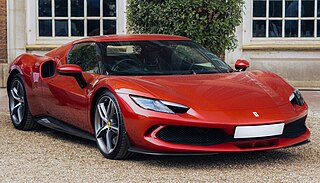
The Ferrari 296 is a sports car built since 2022 by the Italian company Ferrari. The 296 is a two-seater, offered as a GTB coupé and a GTS folding hard-top convertible. It is a plug-in hybrid with a rear mid-engine, rear-wheel-drive layout and its power train combines a twin-turbocharged 120-degree block-angle V6 with an electric drive fitted in between the engine and gearbox. The 296 can be driven in electric-only mode for short distances, to comply with use in urban zero-emission zones.

The Lancia Stratos Zero or Lancia Stratos HF Zero is a grand tourer concept sports car from the Italian automobile manufacturers Bertone and Lancia. It was presented at the 1970 Turin Auto Show, predating the production Lancia Stratos by three years.
























